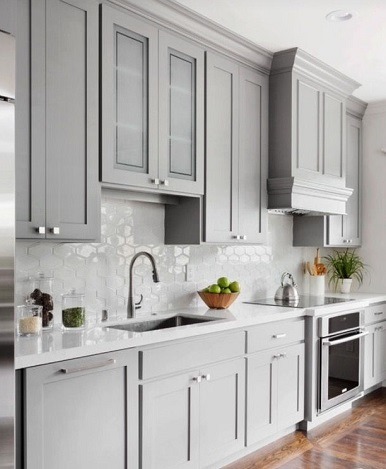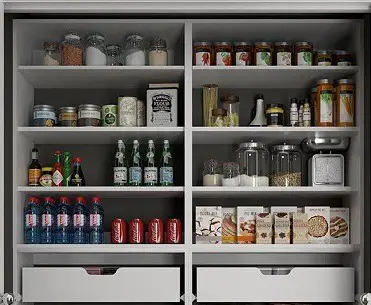If you want to declutter and begin the year with a streamlined, efficient, fresh kitchen, the best area to start with is the pantry and cupboards.
Decluttering your kitchen cupboards is an important step in the process of decluttering your kitchen. You cannot have one without the other.
The kitchen being one of the busiest rooms in your home, suffers from lots of tableware and food gathering in cupboards.
This makes the kitchen cluttered and less efficient to run. Start by evaluating what is slowing down your kitchen processes.
Get rid of what you don’t need and store what you need in a manner that simplifies access and use of those items. Consider tackling the following issues:
Simple cupboard decluttering ideas
-
Cleaning the surfaces
Grime accumulates overtime on shelves and in corners from everyday usage, sauces, food and dust.
With everything removed out of your cupboard, use a damp cloth, freshly perfumed with an essential oil to wipe the shelves and other surfaces.
-
Stack tidily
After cleaning the surfaces, ensure that only the items which are in use find their way back to the cupboards.
You should stack and store up remaining things tidily. This is to ensure they are easily noticeable and easy to reach whenever you open your cupboard.
Think about incorporating additional wire baskets and shelves for more efficient storage for small things.
-
Go for the best quality storage
You should invest for the long term in top quality storage containers, which look great and stack superbly.
Nothing can beat row-upon-row of matching canisters. For bigger items, use baskets and buckets.
-
Think about shelving
Think about open shelving in some sections to reduce lost items at the back of dark cupboards and improve on the functionality of items that you use daily.
You should wipe open shelves frequently, but when the contents are in view, you might be more likely to keep items tidy and clean.
General rules on decluttering your kitchen
Returning home to a cluttered house is a less than perfect situation. It is disturbing how fast a cluttered area will keep on gathering even more unwanted bits and pieces of clutter.
The kitchen remains one of the priority areas in your house that requires good order and a good clean up on a regular basis.
Due to the frequent food preparation activities and every day crumb buildup, the kitchen is one room in your house that might use a bit of attention to control clutter. A tidy kitchen allows you to prepare food more efficiently and clean fast.
Important rules for decluttering your kitchen and kitchen cabinets

1. Put items away in sensible areas
When it is time for returning everything, determine what needs to go where. You should keep regularly used appliances and cookware in easily accessible areas, like in easy to reach cabinets.
Put away things you rarely use out of your kitchen and store them somewhere else.
2. Consider what you do regularly
The kitchen needs to work for you, not against you.
Putting items you don’t use regularly right in the center of your counter, but having to go to different drawers and cupboards all around your kitchen to make a cup of coffee is barely the most realistic use of the space.
Rather, tidy anything that you do not use frequently away (or, if it is not used, dispose it).
Additionally, think about rearranging the kitchen around the activities you do regularly. For instance, consider creating a tea station where teaspoons, tea bags, mugs, and kettle are all in one spot.
3. Throw away or donate
Access every item. Go for maximum utility of every item. So, if you have four pans that are the same, give away one or two.
Dispose of anything that’s not working and cannot be fixed or is missing important components, such as a pan with no handle or other broken appliances that are worthless due to missing or spoilt components.
Do you have enough cutlery or crockery to serve a household of 10 when actually there are only 3 of you?
Many people have more utensils than they actually require, such as lots of spoons, plates and mugs. However, they struggle to dispose of these items as they consider then “beneficial.”
In reality, all you require in the kitchen is sufficient for an everyday meal with your loved ones, plus a few spares in the event of guests or breakage.
4. Organizing things by type

Cookware needs to be categorized by type and put one inside the other, from smallest to biggest, such as nesting dolls.
If there’s space, you should keep lids on their pots for easy access and to avoid the frustration of looking for lids; or else arrange lids from small to big and keep their partners nearby.
5. Be practical with the place you keep items
Thinking realistically is not only about making your usual kitchen activities simpler but also about distributing the items, depending on their level of use, most efficiently.
If you have a heavy item, for example, ensure you put it somewhere low, or else you will never bother removing it again for dread it might fall over on you.
Similarly, for things that you only remove for special events, you should store them in a visibly labeled box.
Since they are for occasional use, store them in the middle or back of your cupboard; ready for you to remove on the odd event they are required.
6. Think practical, not cute
It is very easy to be carried away by cuteness and forget to take into consideration how practical a storage solution is.
For instance, Kilner jars look beautiful when laid out in a roomy pantry, but when crammed into your standard kitchen cupboard, they occupy lots of space because of the thick glass lids and the curved shape.
It is tiring to pour out food out of the heavy Kilner jars; you may have more rice or flour than will fit in the jar.
This leaves you with the issue of having to store the leftovers, and somehow you will need to record each decanted food’s expiry date.
Rather, think practically, either go the decanting way and purchase jars for more efficient usage of the area, or keep the products in their packets and get baskets to group things together.
You can restrict the use of Kilner jars for items which come in small quantities.
7. Arrange food to help you see what you have
Everyone has experienced a scenario where you purchase an entire bunch of ingredients for a recipe, only to discover afterwards that you already had a number of them in your cupboard.
Arranging food so you see what you have is important and helps to minimize the wastage of food. This means you will not continually be purchasing items that you already have in stock.
You don’t have to be obsessive about it; however, an action as easy as arranging the cupboards so that tin labels face frontwards will help to simplify your life and avoid duplicating your purchases.

